If you suspect your calathea has spider mites, don’t panic! Spider mites may sound like a scary problem, but they are generally considered more of an annoyance than anything else.
These tiny insects are actually arachnids, which are the same family as traditional spiders…ok, maybe that’s not as comforting as I was going for.
In any case, while it may be concerning knowing your houseplant is housing, and feeding these pests, treating spider mites on calathea is a fairly easy process and one that most gardeners will face at some point in their gardening career.
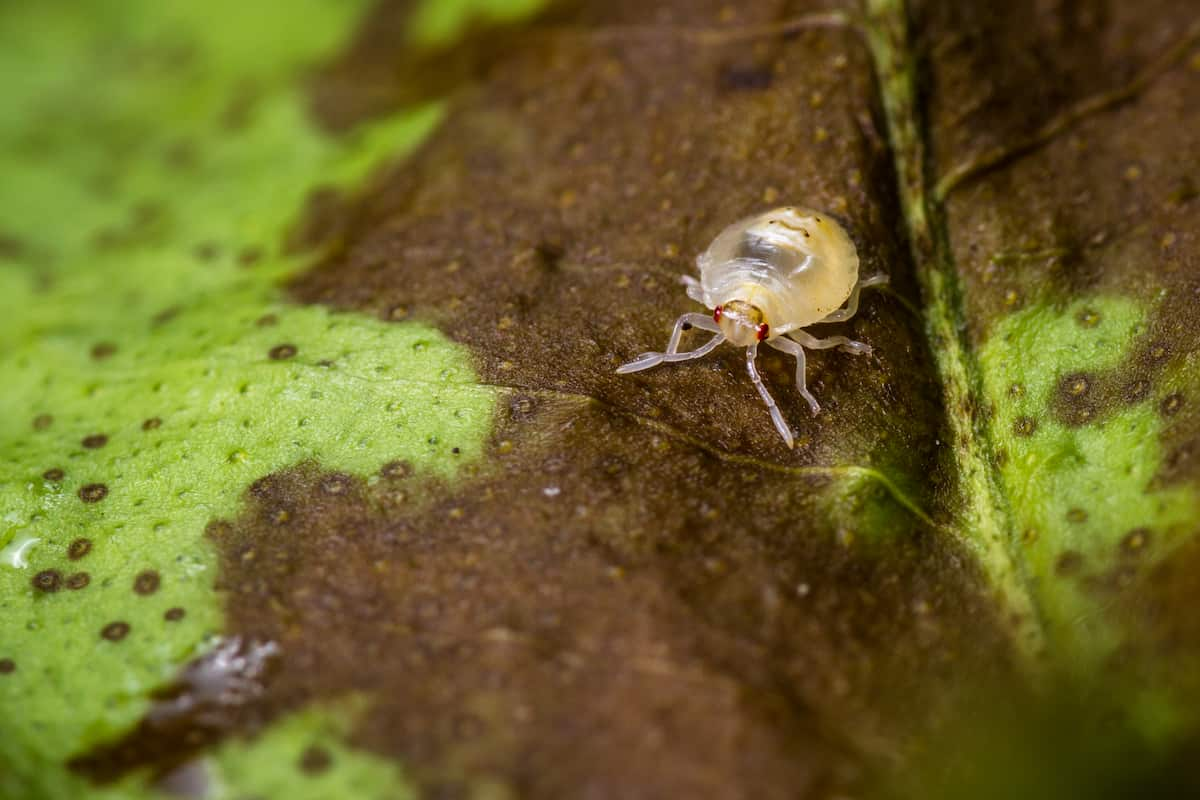
Table of Contents
How do you know if your Calathea has spider mites?
When your calathea has spider mites, the first step is to make sure the issues you are seeing are actually caused by these annoying pests. Once you have confirmed they are the culprit, the proper treatment can begin.
1. Discolored leaves that may look wilted or droopy
As the spider mites feed on the calathea, it will cause the leaves of the plant to start to yellow and either wilt or droop.
In extreme infestations, these leaves may even fall off the plant. In many cases, this is the first sign that you will notice, since it can be seen from afar.
2. Webbing on the leaves, stems or top of the soil
Spider mites spin webs onto the leaves, stems, and soil of the plants they are infesting. These webs help to protect them from predators, allowing them to hide underneath while they feast on the plant.
3. Small brown spots can appear on the leaves
Small, brown or discolored spots will often appear on the leaves where the spider mites have pierced the foliage.
These spots are not usually harmful, but they do have a negative impact on the overall appearance of your calathea.

4. Calathea leaves do not close at night
Healthy calatheas will close their leaves at night and then open them again in the morning. When the calathea has a spider mite infestation, however, their feeding can disrupt the plants’ ability to close their foliage at night.
Keep in mind, however, that there are several reasons as to why the calathea isn’t closing its leaves, and you should assume it is merely the result of spider mites. Instead, look for other signs to confirm the right diagnosis before trying any treatment.
5. The calathea looks unhealthy
When your once healthy calathea starts to look sick, you know something is wrong, and spider mites may just be the problem.
In order to survive, spider mites need the juices and cells that are running throughout the plant. Taking these vital nutrients from the calathea can quickly leave the plant looking worse for wear.
If you notice your calathea looking a bit under the weather, give the plant a good examination and see if you can spot any signs of a spider mite infestation. Once you have confirmed that the calathea has spider mite damage, immediately start treatment.
Why do Calatheas attract spider mites?
Spider mites seem to love plants with thin, delicate leaves that can pierce easily with their sharp mouthparts. However, there hasn’t been any research conducted to find out just why spider mites love calathea plants, but these annoying pests are a common problem for the tropical houseplant.
Thankfully, they’re not typically considered life-threatening to calatheas.
Just because they are not usually life-threatening to your plants, however, doesn’t mean they cannot do irreversible damage. Nor does that mean you should let the plant handle the spider mites without your assistance.
Spider mites can quickly cause a plant to decline, while reproducing and spreading to other plants. The best way to get a handle on the problem is to treat the spider mites at the very first sign of their existence. This will help stop the pests in their tracks.

How do you treat spider mites on Calathea?
Treating spider mites on calathea is, thankfully, not a difficult task, although it can take patience and several applications. Once you have gotten rid of the pests, implement preventive measures for your indoor garden to prevent these or other problems from attacking your calatheas again.
1. Treat the calathea with insecticidal soap
Insecticidal soap is by far one of the most effective methods for treating spider mites on calathea.
This pesticide is considered safer than other types of chemicals since it contains a simple soap solution that is non toxic to humans, pets, birds, and beneficial insects, but can smother spider mites.
You can create your own insecticidal soap by mixing 3 tablespoons of dishwashing liquid (pick one that doesn’t contain bleach or other additives) and 1 gallon of water. Pour the mixture into a spray bottle and then spray the underside of the calathea’s leaves, as well as the tops of the leaves.
Repeat the application once a week until the spider mites are no longer feasting on your calathea.
3. Use neem oil to kill the spider mites
Neem oil is another safer alternative to potentially harmful pesticides. This product is derived from the seeds of the neem tree, which is a tropical tree native to the Indian subcontinent.
The oil has a sulfur or garlic-like odor and bitter taste, which doesn’t kill the spider mites, but it does repel them off of your calathea plants.
To use neem oil, you must first dilute 2 teaspoons of the pesticide in 1 liter of water and then transfer the mixture into a spray bottle. Liberally coat the tops and bottoms of the leaves with the mixture and repeat the process again in 2 weeks.
Alternatively, you can drench the calathea’s soil with neem oil to repel spider mites. When you drench the soil, the calathea will absorb the neem oil into its system, which will then suppress the pests’ desire to munch on the plant.
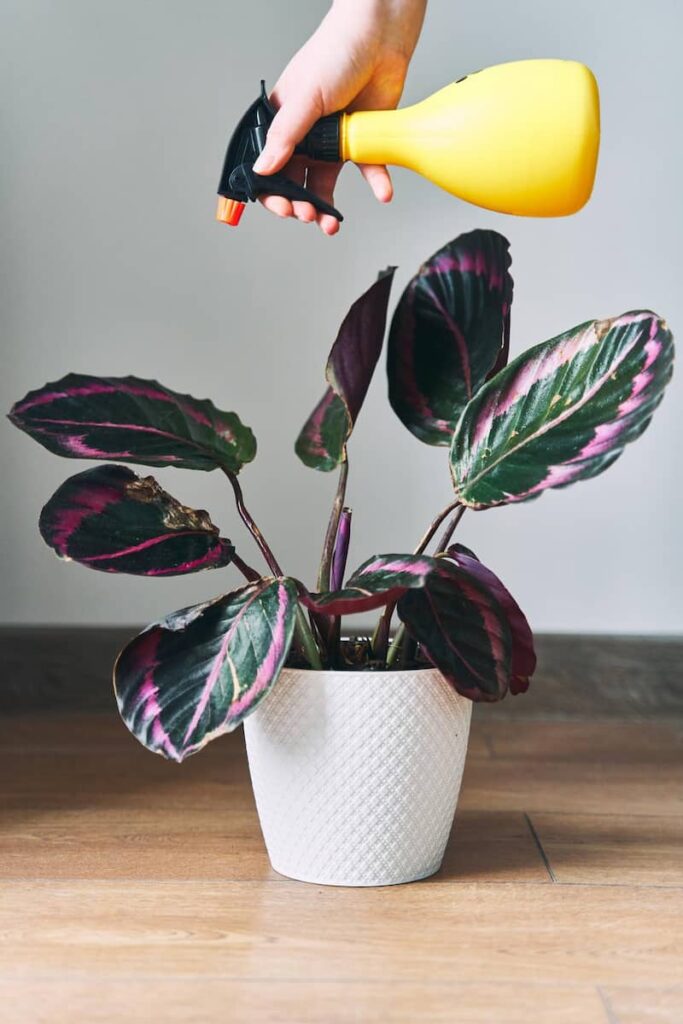
4. Try horticultural oil to get rid of the sap-sucking pests
Horticultural oil is another pesticide option for spider mites that can effectively control these pests.
Neem oil, which is listed above, is a type of horticultural oil, but it isn’t the only one available. There are also horticultural oils where the main compound is mineral oil, vegetable oil, and various other refined oils.
How these products work is that the oil coats the spider mites, blocking their ability to breathe properly. This in turn causes the pests to suffocate and die.
Horticultural oil is considered safe to use around people and pests, but may harm some plants that are sensitive to the substance. While calathea is not overly sensitive to this solution, it can cause the leaves to burn if the oil is applied and the plant is in bright light.
5. Wipe the spider mites off the leaves
Wiping off the spider mites with a damp rag isn’t an effective treatment in of itself, but it can help reduce the spider mites’ numbers in conjunction with other treatment methods.
Use a damp rag and gently wipe the tops and underside of the leaves to remove not just the spider mites, but also their webbing as well.
Take care not to wipe too hard or handle the calathea too roughly, as you can damage its foliage when trying to protect it from these sap-sucking pests.
6. Seek the help of ladybugs
Even though ladybugs may look harmless, these tiny creatures are spider mite killing machines.
They can effectively reduce the number of sap-sucking insects plaguing your calathea, all without the use of any type of chemicals or sprays.
The downside to this, however, is that you will have ladybugs in your home. Because of this, the ladybug option may be better for greenhouses rather than residential homes.
7. Blast the calathea with water
Spraying water on the calathea can help knock spider mites off the plant, as well as wash away their webbing and disrupt their ability to lay eggs.
Keep in mind, however, that high-powered water may damage the calathea, so care must be taken when hosing down the plant.
Furthermore, hosing the calathea water shouldn’t be the only treatment option you use to control spider mites. Instead, use this as merely a tool in your arsenal against these problematic pests.
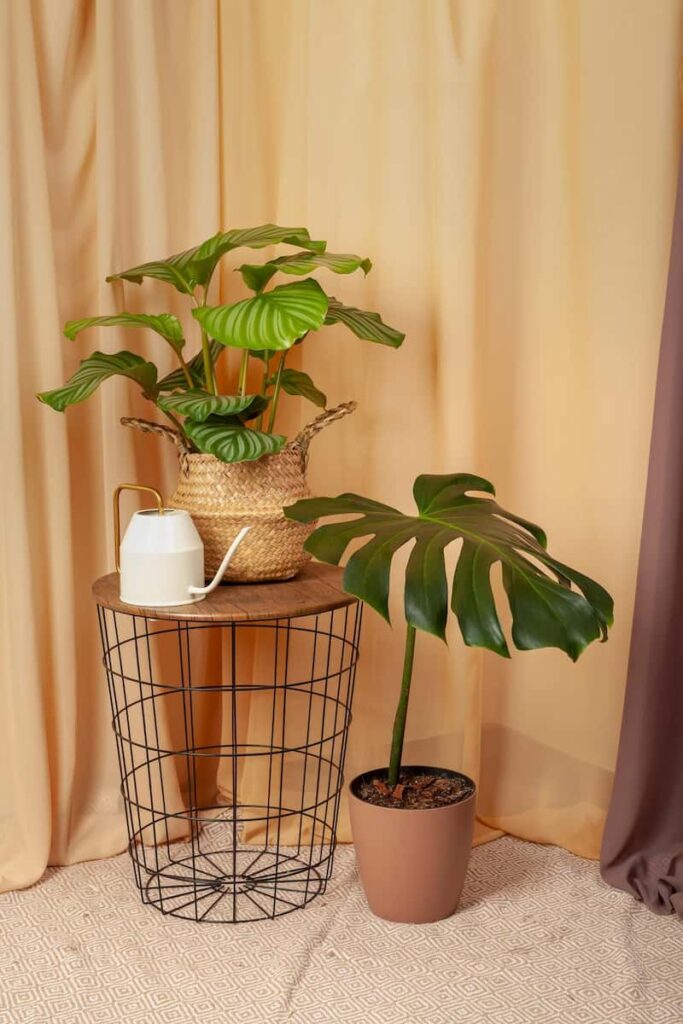
8. Prune damaged leaves
Pruning the damaged leaves won’t necessarily get rid of the spider mites, but it can help improve the overall appearance of the plant while also increasing air flow.
Cutting off any damaged leaves can help reduce the number of spider mites, as well as the amount of eggs, that are currently living on the plant. When you do prune, make sure not to remove more than 1/4 of the plant’s foliage.
Additionally, only use a clean pair of pruning shears when removing the leaves and make sure to sanitize the shears before putting them up. Spider mites can and will travel from one plant to the next via infected pruning shears.
9. Attract beneficial insects
Like the ladybug option, this treatment method is better left for outdoor plants or ones that are growing in a greenhouse.
Attracting beneficial insects that are natural predators of the spider mites, such as lacewings and thrips, is a wonderful way to control sap-sucking pests naturally.
These helpful bugs can be attracted to your garden by planting yarrow, cosmos, goldenrod, and various other beneficial plants.
Can a Calathea recover from spider mites?
In most cases, calatheas will recover from spider mites. If, however, the plant was sickly before the infestation, the damage from these pests can take a toll on the calathea and even kill the plant. Even healthy plants can become stressed when dealing with a spider mite infestation.
That is why it is important to ensure your calathea is well taken care of at all times. This will help the calathea fight off pests and problems, and come out stronger in the end.
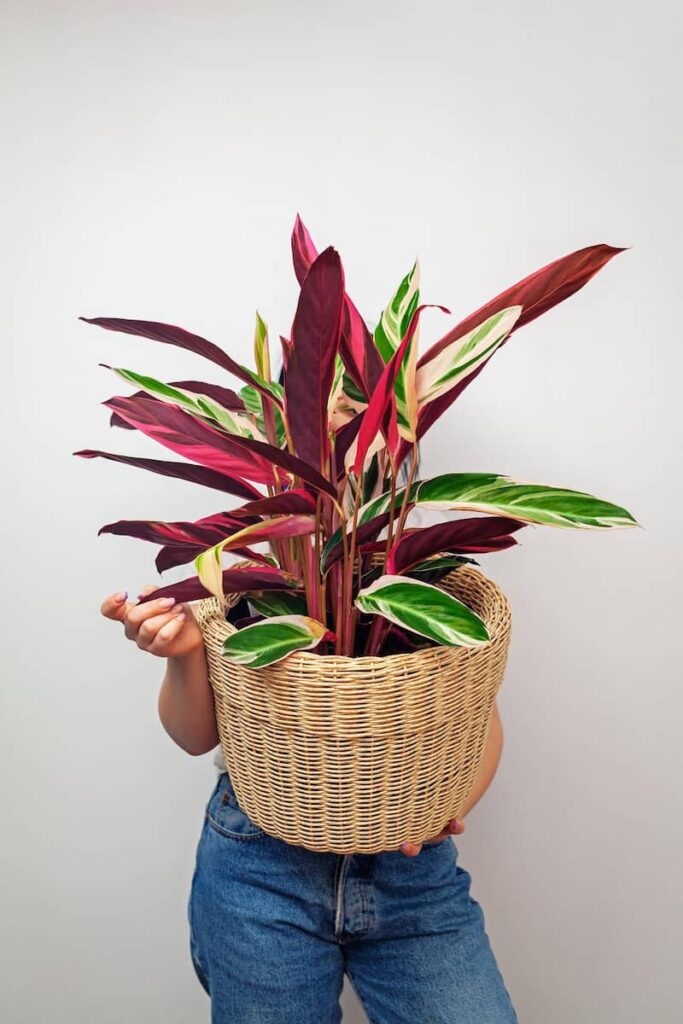
Additionally, you should begin treating spider mites on calathea as soon as you notice the plant is infested, and then utilize more than one treatment option.
For example, you can use both wiping the leaves and applying insecticidal soap treatment options in conjunction with one another. This will help get rid of the spider mites more quickly and effectively than simply using one method.
Should I throw away a Calathea with spider mites?
Unless the spider mite infestation is out of control, you should first try to treat the pests before making the decision to throw away the calathea. In most cases, a calathea that has spider mites can make a complete recovery once proper treatment has been applied.
With that said, however, if the infestation is just severe, you can place the plant in a large trash bag, secure the bag closed, and then take the infested plant to the curb for trash pick up.
Don’t simply allow the infested plant to sit outside without first bagging it up as spider mites can and will move from one plant to the next if the opportunity arises.
Furthermore, never try to compost a plant infested with spider mites as this will only spread the arachnids to other areas of your landscape. You can end up accidently boosting their numbers and then bringing them back indoors to infest the calathea once more.
How do you prevent spider mites on Calathea?
“An ounce of prevention is worth a pound of cure” may be an old saying, but it rings true for most things, including spider mites. Once you have properly rid the calathea of the spider mite infestation, take the necessary steps to prevent them from returning.
1. Keep the calathea healthy and strong
One of the best defenses against spider mites, or any other pests for that matter, is to keep your calathea healthy and strong.
A healthy, strong plant can withstand pests and diseases, and can even snap back quicker if the plant comes under attack.
2. Quarantine all new plants for 14 days
Whenever you bring a new plant inside, you should always quarantine it in a room that is separate from other plants.
Allow the new plant to stay in solitude for 14 days to make sure it isn’t infested with pests or diseases. After the allotted time, if no problems arise, you can add the plant to your indoor garden.

3. Mist the plant with extract
If you want a natural way to help keep spider mites at bay, consider misting the leaves of your calathea with either peppermint or rosemary.
Dilute several drops of rosemary or peppermint extract in water and then mist the tops and undersides of the leaves with the solution. The strong odor that these extracts have can help repel spider mites away from the calathea.
Remember that extracts and essential oils can damage plants, so take care not to apply them at full strength. You may also want to apply a small amount of the mixture to only one leaf to see if it causes damage to the foliage. If it does, immediately discontinue use.
4. Avoid dry air
Spider mites thrive in dry air, and they are not fans of humidity. Thankfully, the calathea is a tropical plant that needs high levels of humidity to thrive.
This means that you can help prevent spider mites from attacking your plant by simply giving it the amount of humidity it needs.
The calathea prefers humidity levels of at least 50 percent. You can achieve this higher humidity by using a humidifier or a drip tray. Not only will this help keep the calathea happy, but you will also create an environment that spider mites do not enjoy.
How long do spider mites live?
The average lifespan of spider mites is 2 to 4 weeks. During this time, however, the female spider mite can lay 20 eggs, which will then hatch and become a breeding adult spider mite in 5 days.
Spider mite infestations typically do not go away on their own and some form of treatment will need to be used to get rid of these pests.
Can spider mites infest a house?
Spider mites won’t just stay on the calathea they are infesting, they are mobile creatures who can and will crawl from one plant to another, and even infest your home. As an added issue, these annoying bugs have the ability to quickly reproduce.
Because of this, you can see why treatment is necessary and should be implemented as soon as you know you are dealing with spider mites.
If spider mites hitch a ride on a plant that you bring inside, the pests can quickly make their way throughout your home. They will look for other plants to infest and, once they find one, will set up residence on the new plant, feasting on its vital plant juices.
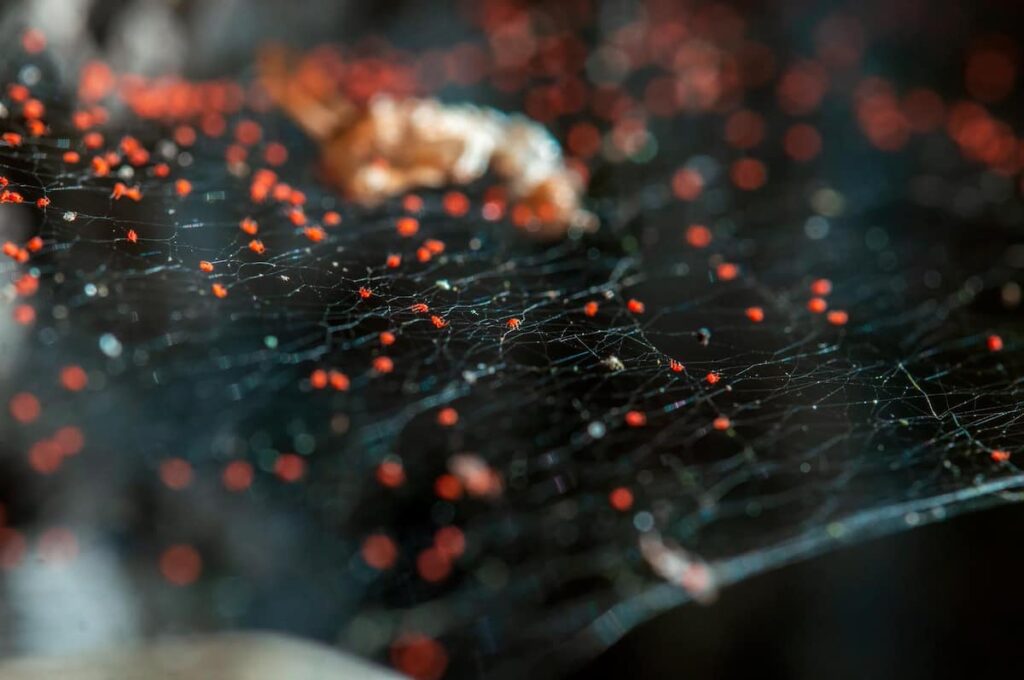
Are spider mites dangerous to humans?
The good news is that spider mites cannot live on humans. This is because these pests need plant material in order to survive. They can, however, crawl on clothing or other items in order to transport themselves to other plants.
What they cannot do is live or feed on humans, or pets for that matter. So you don’t have to worry about these pests biting or harming you or your family, at least!
This means you can make sure your concern is focused on your plant, in particular making sure that these irritating critters aren’t allowed to continue damaging and potentially killing your plants.
